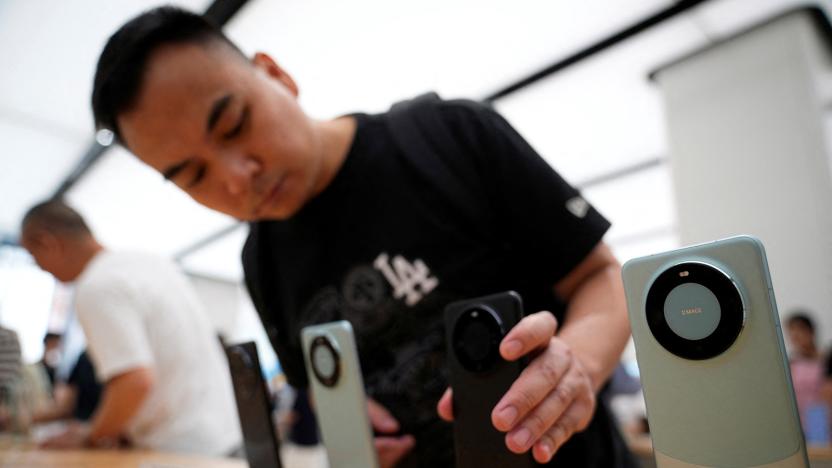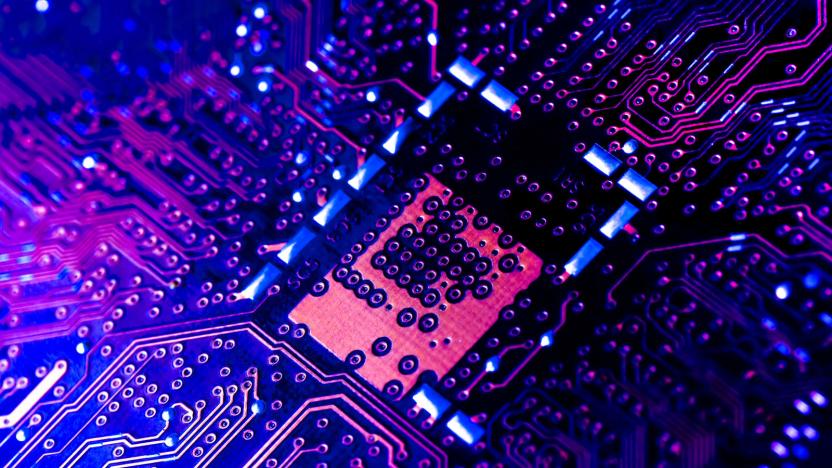lithography
Latest

Huawei is allegedly building a self-sufficient chip network using state investment fund
Huawei is allegedly building a self-sufficient chip network, with help from a Shenzhen city government investment fund.

Samsung says its latest mobile memory is a production breakthrough
Samsung claims to have smashed a production barrier with a new LPDDR5 memory chip for smartphones and other mobile devices.

Self-assembling wires could lead to faster processors
There's a very real fear that processor speed upgrades will slow to a crawl as it becomes increasingly difficult to make denser chips. Don't tell that to a team of researchers at MIT and in Chicago, though -- they've devised a chip-making technique that could keep Moore's Law relevant for a while longer. Their approach produces much finer wires by letting them partly assemble themselves, rather than relying on the very deliberate (not to mention slow) ultraviolet or scanning processes used to make chips today.

Electron microscope draws nano-sized patterns in metal ink
One of the greatest challenges in designing electronics is drawing very fine details. You normally need lithography, which complicates the process by requiring masks. However, Oak Ridge National Laboratory has now found a way to write at an extremely fine level -- and even get a little bit creative. Its researchers have developed a technique that relies on an electron microscope to draw nanoscale patterns using metal ink. The team first creates a grayscale template to guide its work, and uses the microscope to shoot electrons into palladium chloride cells along that template. The cells neatly deposit raw palladium wherever the microscope goes.

Color-changing helmets could warn you about head injuries
Head injuries can be particularly sinister -- unless it's obvious that you took a bad blow, you might not get the help you need in time to mitigate the damage. University of Pennsylvania scientists may have an easy way to raise the red flag when you're hurt, however. They've crafted a polymer that changes color depending on the amount of force, giving anyone around you a sign that you've suffered some trauma. The key was to use holographic lithography to create photonic crystals whose structures change color when they deform. They don't require any power to work, and they're light enough that you could apply them to a helmet without noticing a significant weight difference.

The world's smallest magazine cover is 2,000 times smaller than a grain of salt
No, National Geographic Kids didn't forget to buy colored ink -- that's a blown-up view of the smallest-ever magazine cover, created by IBM to set a Guinness world record. The tech firm used a miniscule, heated silicon "chisel" to etch a polymer image measuring just 11 micrometers by 14 micrometers, or 2,000 times tinier than a grain of salt. The image is more detailed than you might expect at such a miniscule size, too. IBM's instrument responds to subtle changes in pressure in the same way that a 3D printer might, giving it accuracy down to a single nanometer.

Scientists show how to make an integrated circuit using only graphene
IBM built an integrated circuit using graphene back in 2011, but it wasn't a complete breakthrough -- much of the hardware was based on old-fashioned metal and silicon. UC Santa Barbara has gone one step further by showing how to design an IC made exclusively from the advanced substance. The new process shapes circuit components from graphene ribbons whose properties change depending on the pattern; a narrow ribbon is semiconducting, while a wide ribbon is metallic. Chips designed this way should be thinner, more efficient and easier to assemble than their mixed-material counterparts. The catch? Right now, this all-graphene IC exists solely as a computer model. When there are no immediate plans for production, it could be a long while before we see the real thing.

Acronym-loving Samsung joins Intel and TSMC, buys stake in ASML
Samsung's round of cash-flashing continues with a $629 million purchase of a three-percent stake in ASML. It's joining Intel and TSMC in pumping money into the Dutch business, developing tooling for chip-making machines with Extra Ultraviolet Lithography (EUV) designed to "extend Moore's Law." It'll also help reduce the cost of future silicon, since it'll enable the companies to use wider silicon wafers along the manufacturing line. Given that Samsung's investment caps of a project to raise nearly $5 billion in cash and that ASML's home is just five miles west of PSV Eindhoven's stadium, we just hope they threw in a few home tickets for their trouble.

Intel swings 25nm factory doors open for a tour de fab
Intel and Micron's recent announcement that their collective superhero body, appropriately named IM Flash, is sampling 25nm flash chips has been accompanied with a whirlwind tour of their Utah production facilities for a few lucky journalists. PC Perspective bring us the atmospheric photo above, along with some videos, as they prance about one of the most hallowed (and cleanest) environments known to gadget lovers. Apart from the die shrink, the lads also discuss Intel's reputed plans for a G3 SSD refresh some time "later this year" with snappier controllers onboard, which apparently was echoed by Micron who also intend to pump out faster processors with their SSD products. While you wait for all that to happen, hit the source link to find out how and where the stuff that gets put inside SSDs is made.

Researchers develop technique to unscramble light for a much sharper picture
Trying to circumvent the need to choose between getting a wide-angle shot and zooming in for details, a team of researchers at Princeton led by electric engineer Jason Fleischer have developed a new method to get the best of both worlds, by passing the light through a "nonlinear crystal" that would normally distorts the picture. A computer algorithm then pieces together the data and, as they claim, produces a wide-view image that also manages to capture the finer points otherwise missing when using conventional techniques. The goal is to build "super-resolution" microscopes for better medical diagnostics, but the group also sees uses in the fields of data encryption and lithography / microchip production. Is it too much to ask that our next Canon or Nikon have this a standard feature? [Via PhysOrg]

Researchers using nano-imprint lithography to make LEDs brighter
Considering that there are quite a few nations out there aiming to ditch incandescent bulbs in the not-too-distant future, it follows logic that we should start making LEDs more suitable for in-home use. Of course, we've already seen a couple of advancements in the area, but scientists at Glasgow University -- along with the Institute of Photonics at the University of Strathclyde -- have reportedly found a way to make traditional LEDs a fair bit brighter. The process, dubbed nano-imprint lithography, involves "making microscopic holes in the surface of LEDs to increase the level of light they give off." Unfortunately, said process is still quite time consuming and expensive, but you can rest assured they're working to make the process quicker, simpler and cheaper for the good of mankind.[Via FarEastGizmos]



